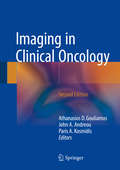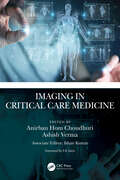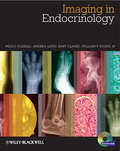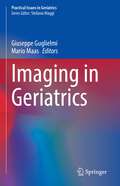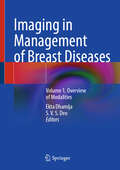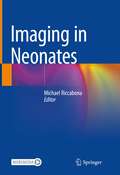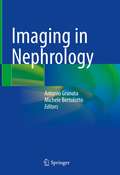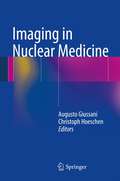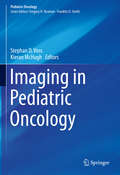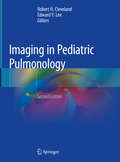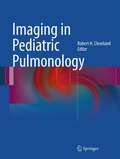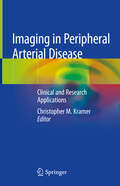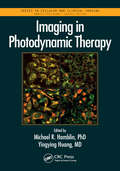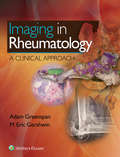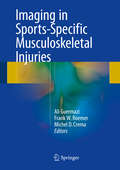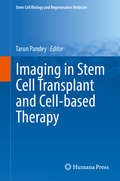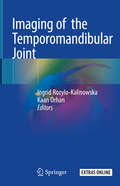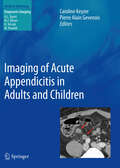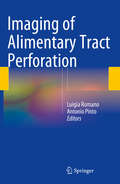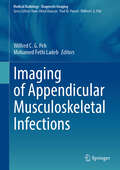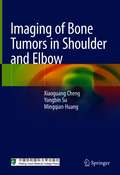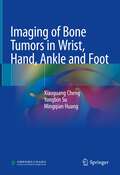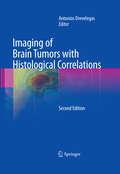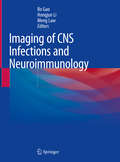- Table View
- List View
Imaging in Clinical Oncology
by Athanasios D. Gouliamos John A. Andreou Paris A. KosmidisThis is the second edition of a well-received book reflecting the state of the art in oncologic imaging research and promoting mutual understanding and collaboration between radiologists and clinical oncologists. It presents all currently available imaging modalities and covers a broad spectrum of oncologic diseases for most organ systems. Today, oncologic imaging faces the challenge of improving and refining concepts for precise tumor delineation and biologic/functional tumor characterization, as well as for purposes of creating individual treatment plans. The concept of radiomics has further advanced the conversion of images into mineable data and subsequent analysis of said data for decision-making support. Since the release of the book’s first edition, radiomics has been introduced in oncology studies and can be performed with tomographic images from CT, MRI and PET/CT studies. The combination of radiomic data with genomic features is known as radiogenomics, and can potentially offer additional decision-making support. This book will be of interest to clinical oncologists with regard to the diagnosis, staging, treatment and follow-up on various tumors affecting the CNS, chest, abdomen, urogenital and musculoskeletal systems.
Imaging in Critical Care Medicine
by Ashish Verma Anirban Hom Choudhuri Ishan KumarImaging in critically ill patients is a ubiquitous but challenging line of investigation for the physician as accurate interpretation is often difficult as patient cooperation during the procedure is grossly compromised, and the resultant image is often suboptimal. This book provides details on principles of imaging and the diagnostic hallmarks of common diseases to assist in correct interpretation. It contains guidance to overcome the deficiencies observed during the performance of bedside imaging and equipment handling and addresses the rationale for various procedural/management and imaging approaches. This is a useful companion for most doctors and trainees working in critical care settings. Key Features • Features case-based scenarios in critical care as well as a section on tropical diseases• Appeals to a wide audience of trainees and consultants of critical care medicine, internal medicine, anaesthesiology, pulmonary medicine and those working in the ICU, due to its clinical relevance• Reduces the dependency on the radiologist and helps the physician save time, enhancing the quality of patient care
Imaging in Endocrinology
by Paolo Pozzilli Bart L. Clarke Andrea Lenzi William F. Young Jr.Imaging in Endocrinology will provide endocrinologists and radiologists of all levels with an outstanding diagnostic imaging atlas to aid them in the diagnosis and management of all the major endocrine diseases they are likely to encounter.In full colour throughout, the 300 high-quality images consist of CT scans, MRI, NMR and histopathology slides, and are arranged by each specific endocrine condition, resulting in a visually outstanding and easily accessible tool that guides the user through exactly what to look out for and provides a practical and extremely useful aid in helping them formulate a diagnosis. Every major endocrine condition is covered in a specific section, including diseases of the thyroid, pituitary, reproductive and adrenal glands, the pancreas, bone metabolism problems, and the various forms of endocrine cancers. Each disease covered will offer a comparison of the normal findings so as to further assist in diagnosis. An accompanying website contains an online slide-atlas of all the figures in the book, to allow users to download all figures for use in presentations.Led by Paolo Pozzilli, an internationally-recognised expert in this field, the authors have assembled a wonderful collection of images that will be greatly valued by endocrinologists and radiologists alike, ensuring this is the perfect tool to consult when assessing patients with endocrine disease.
Imaging in Geriatrics (Practical Issues in Geriatrics)
by Giuseppe Guglielmi Mario MaasThis book addresses in a structured and multidisciplinary way the medical issues related to aging, paying particular attention to the role of diagnostic imaging in the field of cardiovascular, musculoskeletal, respiratory, neurological, urogenital and gastrointestinal diseases.The progressive increase of the average age of the population, of life expectancy and the improvement of the quality of life are common phenomena in many countries of the World. Over the years, the management of older persons seems to have had an increasing impact both on the socio-economic and on the medical-health level. Medicine, in all its branches, has in fact focused more and more on the health conditions of the elderly patient and its protection and, in this context, due to the increasing progress in the field of technology and imaging methods, the radiologist occupies a front-line position. Unlike the young or middle-aged patients, the elderly need special care and attention, especially because of the involutive-degenerative senile processes they have to face, which must be taken into account to avoid incurring into misdiagnosis. Radiology, in fact, aims more and more at developing imaging techniques that are on the one hand satisfactory and comprehensive, but at the same time that do not represent any risk and/or obstacle for the elderly patient. The aim of this book is to provide the radiologist, and not only, with an adequate and complete geriatric preparation, thus to improve the diagnostic-therapeutic management of those patients who, to date, constitute the most conspicuous part of the medical-health users.
Imaging in Management of Breast Diseases: Volume 1, Overview of Modalities
by S. V. S. Deo Ekta DhamijaThis two-volume book covers the multimodality approach to various breast pathologies with special emphasis on the role of imaging in the diagnostic and management algorithm. The book provides a stepwise clinico-radiological approach while highlighting the crucial role of imaging at each step of patient evaluation. It has been divided into two volumes. The first volume focuses on a basic overview of clinico-radiological concerns in the field of breast imaging and the second volume provides a precise disease-based approach in various clinical scenarios. This volume describes epidemiology of breast diseases; indications and utility of various imaging modalities, breast interventions; pathological, surgical and medical aspects of breast carcinoma in diagnostic population. It includes dedicated chapters on advances in breast imaging modalities like contrast enhanced mammography and the update on artificial intelligence in the present era. Pathological assessment is an integral component for evaluation of breast diseases, and it is important to understand the role and impact of rad-path correlation in the treatment protocol of the patients. This book provides insight into not only pathological aspects; but also introduces the surgical, medical and palliative facets of patient management. The book is beneficial for practitioners, residents and fellows in radiology, pathology, surgical and medical oncology disciplines.
Imaging in Neonates
by Michael RiccabonaThis book provides a concise overview of neonatal imaging. After a short clinical introduction on the crucial role of imaging in diagnosing and treating neonatal conditions, it discusses the various methods (ultrasound, digital radiography, fluoroscopy, CT, and MRI) available and explains in detail how they have to be adapted for neonatal applications. Chapters feature imaging findings and differential diagnoses for the most common neonatal conditions. Additionally, some relevant aspects of foetal imaging are presented. Written by an interdisciplinary team, Imaging in Neonates is a practical resource for daily use in the ward for all medical professionals involved in treating neonates.
Imaging in Nephrology
by Michele Bertolotto Antonio GranataThis book is a wide-ranging guide to current and emerging applications of ultrasonography within nephrology that aims to provide readers with a sound understanding of the rationale for the use of ultrasound techniques in various disease settings, for example, complications following renal transplantation, arteriovenous fistulas, renal artery stenosis, nonstenotic renal artery pathology, renal vein pathology, aortic disease, and acute renal failure. Particular emphasis is placed on newer applications, such as those involving elastosonography, contrast-enhanced ultrasonography, and color Doppler imaging. There is no doubt that ultrasound techniques can improve the standard of care in nephrology, from vascular access planning to management of uremic complications. Nevertheless, many nephrologists continue to delegate the performance of ultrasonography to radiologists or other colleagues, which is especially regrettable given the advent of affordable, portable ultrasound scanners. This book will be of value for all clinicians interested in the role of ultrasound techniques in nephrology and will be especially useful for nephrologists seeking to incorporate ultrasonography into their practice.
Imaging in Nuclear Medicine
by Christoph Hoeschen Augusto GiussaniThis volume addresses a wide range of issues in the field of nuclear medicine imaging, with an emphasis on the latest research findings. Initial chapters set the scene by considering the role of imaging in nuclear medicine from the medical perspective and discussing the implications of novel agents and applications for imaging. The physics at the basis of the most modern imaging systems is described, and the reader is introduced to the latest advances in image reconstruction and noise correction. Various novel concepts are then discussed, including those developed within the framework of the EURATOM FP7 MADEIRA research project on the optimization of imaging procedures in order to permit a reduction in the radiation dose to healthy tissues. Advances in quality control and quality assurance are covered, and the book concludes by listing rules of thumb for imaging that will be of use to both beginners and experienced researchers.
Imaging in Pediatric Oncology (Pediatric Oncology)
by Stephan D. Voss Kieran McHughThis book, co-authored by an internationally acclaimed team of experts in the field of pediatric oncologic imaging, provides a comprehensive update on new advances in diagnostic imaging as they relate to pediatric oncology. In contrast to other oncologic imaging texts focusing on the radiology of specific tumors, this book emphasizes the important fundamentals of imaging that every child with a new or treated malignancy receives. Guidance is provided on the selection and use of appropriate imaging techniques, with individual chapters devoted to each of the major cross-sectional imaging modalities used in the detection and follow-up of pediatric cancers, including PET-CT, PET-MRI, whole-body MRI, and diffusion-weighted MRI. Additional nuclear medicine techniques are addressed, and detailed attention is paid to more advanced areas of practice such as contrast-enhanced ultrasound, pediatric interventional radiology techniques, radiation treatment planning, and radiation dose considerations (ALARA). Other areas covered include screening of children with cancer predisposition syndromes, treatment related complications, potential pitfalls during neuro-oncologic imaging, and the risks and benefits inherent in post-therapy surveillance imaging.
Imaging in Pediatric Pulmonology
by Robert H. Cleveland Edward Y. LeeThis fully updated second edition is a definitive guide to imaging and differential diagnosis for pediatric pulmonary diseases and disorders. This edition is fully updated to include coverage of the latest imaging and diagnostic techniques, modalities, and best practices. Beginning with clinical algorithms, chapters provide a framework for clinical diagnosis. This image-based text presents a comprehensive, multi-modality approach, with an emphasis on plain film and cross-sectional imaging. The imaging sections, including a new chapter on pediatric thoracic MRI, are correlated with pathology and clinical findings to help readers learn what the modality of choice can enable them to see. This information and guidance is applied directly to diseases and disorders seen in everyday practice, including pleural effusion, focal lung disorders, pulmonary hypertension, cystic fibrosis, and asthma, as well as a new chapter on pediatric pulmonary embolism. In addition, a new chapter on the genetics of pediatric lung disorders has been added. This essential guide gives pediatric pulmonologists and radiologists the information to identify the differentials by symptom complex, accordingly determine what test would be effective, how to proceed, and to essentially provide the best care for their patients.
Imaging in Pediatric Pulmonology
by Robert H. ClevelandImaging in Pediatric Pulmonology is a definitive reference to imaging and differential diagnosis for pediatric pulmonology. Diseases and disorders seen in everyday clinical practice are featured, including infections, developmental disorders, airway abnormalities, diffuse lung diseases, focal lung diseases, and lung tumors. Organized to support the clinical thought process, the text begins with a series of clinical algorithms that provide a starting point for formulating a diagnosis. The physician will be able to identify the differentials by symptom complex and accordingly determine what test would be effective and how to proceed. The balance of the book is image-based and presents a comprehensive, multi-modality approach, with an emphasis on plain film and cross-sectional imaging. The imaging sections are correlated with pathology and clinical findings to help readers learn what the modality of choice can enable them to see. Edited by Robert H. Cleveland, MD, Professor of Radiology at Harvard Medical School and Chief of the Division of Diagnostic Radiology at Children's Hospital Boston, the book includes a talented group of associate editors and contributing authors who are noted experts in pathology, pulmonology, and radiology, making Imaging in Pediatric Pulmonology an ideal reference for all physicians involved in the diagnosis and treatment of pediatric pulmonary issues.
Imaging in Peripheral Arterial Disease: Clinical and Research Applications
by Christopher M. KramerThis book presents up-to-date information on clinical and research applications of imaging in peripheral arterial disease (PAD). It provides high-quality images useful not only in the diagnosis of PAD but also for use in clinical trials aimed at the development of novel therapies such as angiogenic agents and stem cells. The book begins with coverage of the applications of the four major imaging modalities in a clinical setting: ultrasound, computed tomography angiography (CTA), magnetic resonance angiography (MRA), and digital subtraction angiography (DSA). It also discusses the ankle brachial index (ABI) as a screening technique to establish the presence of PAD. Subsequent chapters focus on the advantages and limitations of various research applications of imaging in PAD including contrast ultrasound for measuring perfusion; MRI for assessing perfusion, energetics, plaque volume, and characteristics; and radionuclide imaging for perfusion and inflammation. Imaging in Peripheral Arterial Disease: Clinical and Research Applications is an essential resource for physicians, researchers, residents, and fellows in cardiology, radiology, imaging, nuclear medicine, diagnostic radiology, and vascular surgery.
Imaging in Photodynamic Therapy (Series in Cellular and Clinical Imaging)
by Michael R. Hamblin Yingying HuangThis book covers the broad field of cellular, molecular, preclinical, and clinical imaging either associated with or combined with photodynamic therapy (PDT). It showcases how this approach is used clinically for cancer, infections, and diseases characterized by unwanted tissue such as atherosclerosis or blindness. Because the photosensitizers are also fluorescent, the book also addresses various imaging systems such as confocal microscopy and small animal imaging systems, and highlights how they have been used to follow and optimize treatment, and to answer important mechanistic questions. Chapters also discuss how imaging has made important contributions to clinical outcomes in skin, bladder, and brain cancers, as well as in the development of theranostic agents for detection and treatment of disease. This book provides a resource for physicians and research scientists in cell biology, microscopy, optics, molecular imaging, oncology, and drug discovery.
Imaging in Rheumatology: A Clinical Approach
by M. Eric Gershwin Adam GreenspanImaging in Rheumatology: A Clinical Approach is ideal for radiologists and rheumatologists—as well as orthopedic surgeons and others interested in applying imaging to rheumatologic diseases—and stresses conventional radiography as the most effective imaging assessment technique to help diagnose various diseases and conditions. Greenspan and Gershwin—a radiologist and rheumatologist, respectively—focus on practical, everyday use, so you can apply knowledge you learn in any clinical setting.
Imaging in Sports-Specific Musculoskeletal Injuries
by Ali Guermazi Frank W. Roemer Michel D. CremaMost books on imaging in sports medicine are concerned with the particular joints or anatomy involved in sports-related injuries. This book, however, takes a different perspective by looking at injuries that are associated with specific sports. All of the well-known major sports, such as football, tennis, and basketball, are included, as are many less common but still very popular sports, such as baseball, American football, and rugby. The chapters on sports-specific injuries are preceded by two chapters on the perspective of clinicians and another two chapters on the general use of MR imaging and ultrasound in sports medicine. The authors of the book are world-renowned experts from five continents. Imaging in Sports-Specific Musculoskeletal Injuries should be of great interest to radiologists, sports medicine physicians, orthopedic surgeons, and rehabilitation physicians, and to anyone interested in the treatment of sports-related injuries.
Imaging in Stem Cell Transplant and Cell-based Therapy
by Tarun PandeyThis book provides a review of imaging techniques and applications in stem cell transplantation and other cell-based therapies. The basis of different molecular imaging techniques is explained in detail, as is the current state of interventional radiology techniques. While the whole is a comprehensive discussion, each chapter is self-sufficient enough so that each can be reviewed independently. The contributors represent years of international and cross-disciplinary expertise and perspective and are all well known in their fields. comprehensive information on the role of clinical and molecular imaging in stem cell therapy from this book reviewed in detail. Essential reading for radiologists and physicians who are interested in developing a basic understanding of stem cell imaging and applications of stem cells and cell based therapies. However, it will also be of interest to clinical scientists and researchers alike, including those involved in stem cell labeling, tracking & imaging, cancer therapy, angiogenesis and cardiac regeneration.
Imaging of the Temporomandibular Joint
by Ingrid Rozylo-Kalinowska Kaan OrhanThis superbly illustrated book is designed to meet the demand for a comprehensive yet concise source of information on temporomandibular joint (TMJ) imaging that covers all aspects of TMJ diagnostics. After introductory chapters on anatomy, histology, and the basics of radiological imaging, detailed guidance is provided on the use and interpretation of radiography, CT, CBCT, ultrasound, MRI, and nuclear medicine techniques. Readers will find clear presentation of the imaging findings in the full range of TMJ pathologies, from intrinsic pathological processes to invasion by lesions of the temporal bone and mandibular condyle. Careful attention is also paid to the technical issues confronted when using different imaging modalities, and the means of resolving them. The role of interventional radiology is examined, and consideration given to the use of arthrography and arthrography-guided steroid treatment. In addition, an overview of recent advances in research on TMJ diagnostics is provided. Imaging of the Temporomandibular Joint has been written by an international team of dedicated authors and will be of high value to clinicians in their daily practice.
Imaging of Acute Appendicitis in Adults and Children
by Caroline Keyzer Pierre Alain GevenoisThis book is a comprehensive account of imaging of acute appendicitis and other appendiceal diseases. Background information is first provided on clinical presentation, perforation and negative appendectomy rates, and treatment options. The role of each imaging modality - radiography, ultrasound, CT, and MRI - is then considered separately in adults and children with suspected acute appendicitis. Many high-quality illustrations are included, and detailed information is provided on appropriate protocols and radiation saving. Further chapters addresses the spontaneously resolving and chronic appendicitis as well as other appendiceal lesions and review the findings of evidence-based medicine and cost-effectiveness analyses. Emergency physicians, pediatricians, surgeons, and radiologists will all find this book to be an excellent source of information and guidance.
Imaging of Alimentary Tract Perforation
by Antonio Pinto Luigia RomanoThis book provides an overview on the critical role of diagnostic imaging in the assessment of patients with suspected alimentary tract perforation, an emergent condition that requires prompt surgery. With the aid of numerous high-quality images, it is described how different imaging modalities, including plain film X-ray, ultrasonography and multidetector row computed tomography (MDCT), permit correct diagnosis of the presence and cause of the perforation and of associated pathologies. Particular attention is paid to MDCT, with full description of its role in a range of scenarios at various levels of the alimentary tract. Imaging of GI tract perforation in different patient groups, such as pediatric patients, the elderly and oncologic patients, is also addressed. This volume will greatly assist residents in radiology, radiologists and physicians who are daily involved in the management of patients with clinically suspected alimentary tract perforation.
Imaging of Alimentary Tract Perforation
by Luigia Romano and Antonio PintoThis book provides an overview on the critical role of diagnostic imaging in the assessment of patients with suspected alimentary tract perforation, an emergent condition that requires prompt surgery. With the aid of numerous high-quality images, it is described how different imaging modalities, including plain film X-ray, ultrasonography and multidetector row computed tomography (MDCT), permit correct diagnosis of the presence and cause of the perforation and of associated pathologies. Particular attention is paid to MDCT, with full description of its role in a range of scenarios at various levels of the alimentary tract. Imaging of GI tract perforation in different patient groups, such as pediatric patients, the elderly and oncologic patients, is also addressed. This volume will greatly assist residents in radiology, radiologists and physicians who are daily involved in the management of patients with clinically suspected alimentary tract perforation.
Imaging of Appendicular Musculoskeletal Infections (Medical Radiology)
by Wilfred C. G. Peh Mohamed Fethi LadebMusculoskeletal infections are a diagnostic challenge due to their frequently non-specific clinical presentations. Imaging has a key role in the evaluation of various infections affecting the extremities, in aiding timely and appropriate patient management, and reducing the risk of patient morbidity. This book begins by giving an overview and classification of infections that affect the appendicular skeleton, joints and soft tissues. The pathophysiology and histopathology of these infections, and the practical applications of key diagnostic techniques such as microbiology, various types of diagnostic imaging and interventional radiology are addressed. The full range of pyogenic infections, as well as tuberculosis, melioidosis and cystic echinococcosis, are covered in detail. Imaging of various fungal infections and atypical infections are also addressed. Specific chapters are dedicated to important topics such as post-traumatic and orthopedic hardware-related infections, pediatric musculoskeletal infections, musculoskeletal infections in AIDS, and the diabetic foot. The last chapter provides an algorithmic approach defining the diagnosis and management of appendicular musculoskeletal infections. This book fills a gap in the literature by providing an updated and richly-illustrated imaging book that comprehensively covers appendicular musculoskeletal infections in a structured fashion.
Imaging of Bone Tumors in Shoulder and Elbow
by Xiaoguang Cheng Yongbin Su Mingqian HuangThis book provides a detailed description of typical imaging features of bone tumors and tumor-like lesions in the shoulder and elbow. Each chapter deals with one major bone tumor or tumor-like lesion, for example, giant cell tumor, bone cyst, osteochondroma, chondrosarcoma, Ewing sarcoma, bone metastases, lymphoma, etc. Typical cases are carefully selected from thousands of clinical cases accompanying with comprehensive imaging information of X-ray, CT and MRI. In-depth analysis and differential diagnostic tips from experienced bone tumor specialist are presented at the end of each case. This book will be useful and worthy to musculoskeletal radiologists, orthopaedic surgeons, general radiologists, and oncologists.
Imaging of Bone Tumors in Wrist, Hand, Ankle and Foot
by Xiaoguang Cheng Yongbin Su Mingqian HuangThis book provides a detailed description of typical imaging features of bone tumors and tumor-like lesions in the wrist, hand, ankle and foot. Each chapter deals with one major bone tumor or tumor-like lesions, for example, chondroma, enchondroma, gout, giant cell tumors, lymphoma, osteosarcoma, bone metastases, etc. Typical cases are carefully selected from thousands of clinical cases accompanying with comprehensive imaging information of X-ray, CT and MRI. In-depth analysis and differential diagnostic tips from experienced bone tumour specialists is presented at the end of each chapter. This book will be useful and worthy to musculoskeletal radiologists, orthopaedic surgeons, general radiologists, and oncologists.
Imaging of Brain Tumors with Histological Correlations
by Antonios DrevelegasThis volume provides a deeper understanding of the diagnosis of brain tumors by correlating radiographic imaging features with the underlying pathological abnormalities. All modern imaging modalities are used to complete a diagnostic overview of brain tumors with emphasis on recent advances in diagnostic neuroradiology. High-quality illustrations depicting common and uncommon imaging characteristics of a wide range of brain tumors are presented and analysed, drawing attention to the ways in which these characteristics reflect different aspects of pathology. Important theoretical considerations are also discussed. Since the first edition, chapters have been revised and updated and new material has been added, including detailed information on the clinical application of functional MRI and diffusion tensor imaging. Radiologists and other clinicians interested in the current diagnostic approach to brain tumors will find this book to be an invaluable and enlightening clinical tool.
Imaging of CNS Infections and Neuroimmunology
by Meng Law Bo Gao Hongjun LiThis book summarizes the imaging characteristics and theory of CNS infections, serving as a clinical guidance and having a practical significance for the understanding, prevention and diagnosis of infectious neurology. It includes extensive CT, MRI images on gross anatomy, pathological tissue, immunohistochemistry, electronic speculum, etc. It is divided into 19 chapters according to infectious types.On the basis of imaging diagnosis, through the cross research of imaging with autopsy and pathology, the imaging characteristics and evolution was revealed. This book will be a valuable reference on the clinical practice and research of neuroinfections.
